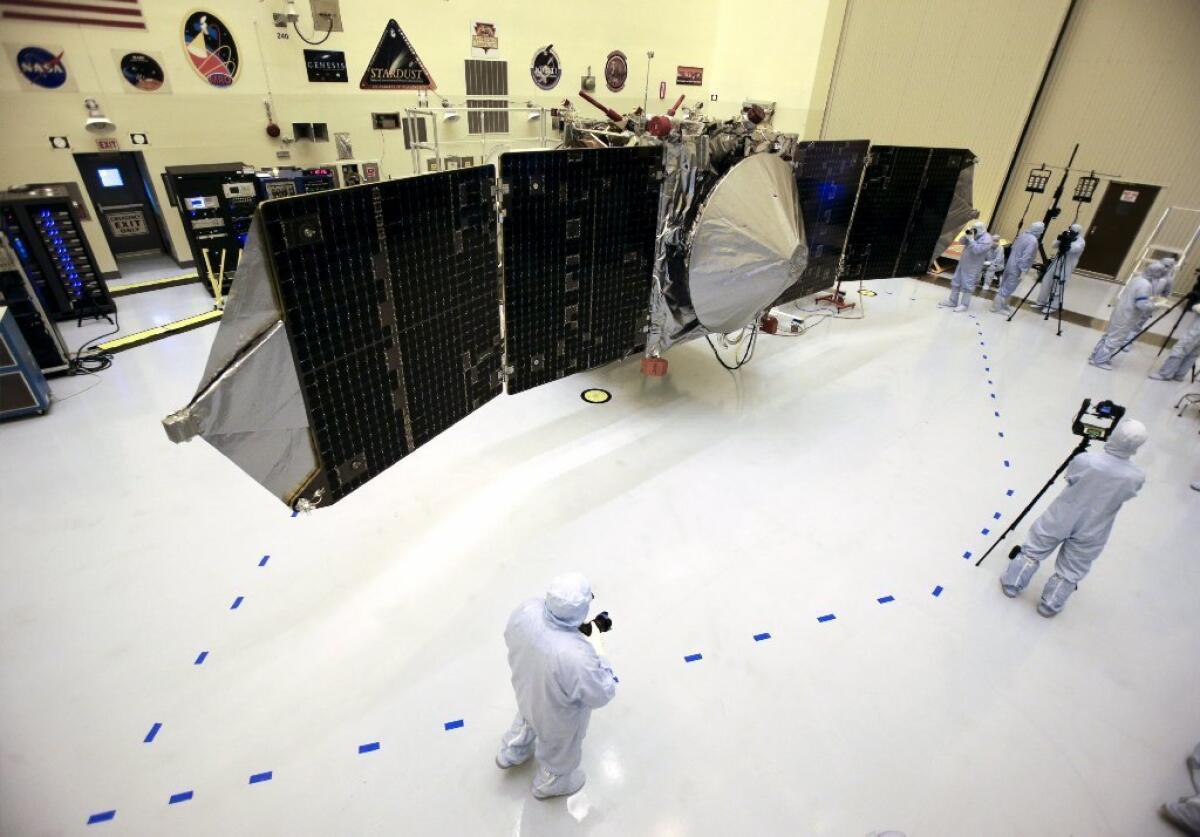NASA: Government shutdown won’t stop MAVEN launch to Mars

Planetary scientists are breathing a sigh of relief as NASA’s MAVEN mission to Mars has been cleared for takeoff. The Mars Atmosphere and Volatile EvolutioN mission, slated for launch as early as Nov. 18, had been put on hold after this week’s government shutdown, raising fears that the spacecraft would miss the launch window and be grounded for years.
“I learned this morning that NASA has analyzed the MAVEN mission relative to the Anti-Deficiency Act and determined that it meets the requirements allowing an emergency exception,” Bruce Jakosky, MAVEN’s lead scientist based out of the University of Colorado in Boulder, said in an email.
MAVEN, set for launch between Nov. 18 and Dec. 7, will play a crucial role as a communications relay between Earth and the rovers Curiosity and Opportunity, Jakosky said. That’s a function currently carried out by two aging satellites, Mars Odyssey (launched in 2001) and the Mars Reconnaissance Orbiter (launched in 2005).
“Wow, that’s good news,” said UCLA planetary scientist David Paige, who was not involved in the mission. Paige said the mission had been on his mind all day.
“The whole notion that they wouldn’t launch this thing is just appalling,” Paige said. “You have this whole rocket almost on the launchpad.”
In response to the government shutdown, NASA furloughed 97% of its roughly 18,000 workers, halting almost all but the most essential activities.
The freeze left MAVEN’s team of scientists and engineers in a lurch – many of them had already flown from all over the country to NASA’s Kennedy Space Center in Cape Canaveral, Fla., to set up for the launch.
Had MAVEN not escaped the funding freeze, the team could have pushed a launch to Dec. 15 at the latest, about a week after the end of its official launch window, Jakosky said. But beyond that, Earth and Mars would have fallen out of ideal alignment.
“This would have precluded having sufficient fuel for MAVEN to carry out its science mission and to operate as a relay for any significant time,” Jakosky said. This would have left the mission grounded for several years until the next available launch window.
The MAVEN mission will explore the evolution of the Martian atmosphere, and will probe whether its cold, thin, dry shell of air was once thick and ideal for microbial life. In its elliptical orbit, it will swoop down to just 77 miles above the surface to taste each layer of the top of the atmosphere and then get a bird’s eye view of the entire planet at its highest point, 3,728 miles above the planet.
Although MAVEN was deemed necessary for technical support and not science values, the science would still benefit, Jakosky said.
“Launching in 2013 allows us to observe at a good time in the 11-year solar cycle,” he said.
[Updated 6:10 p.m.: The spacecraft was shipped to the Kennedy Space Center on Aug. 2, giving the team three months to work through an enormous to-do list and get the spacecraft ready for launch.
Among the list of more than a dozen tasks: Inspect, clean and prepare the spacecraft after shipping; reinstall parts that had been removed for the journey; load fuel; attach the spacecraft into the payload support structure and later to the Atlas and Centaur rockets; and roll the 5,622-pound craft out to the launchpad.
“There really are a lot of things to be done before it’s ready,” Jakosky said. “So far, we’ve gotten through about the first four items on this list.... Now that we’re back at work, we’re on track to be able to do the others between now and Nov. 18. It will take a lot of hard work and some long days, but it’s doable on that schedule.”]
ALSO:
That’s no crater! First explosive supervolcanoes found on Mars
Eureka! Did crashing neutron stars forge all gold in Universe?
A hunt for dark matter in a former gold mine
50 shades of window? ‘Smart glass’ blocks heat, light at flip of switch







